
For the people who want to know the details: This film shows the making of a Pain Rustique French style bread based on a sourdough poolish (12 hour, 100%) with a high hydration dough, autolyse and stretch and fold technique in our Rofco hearth bread oven. We use German banneton’s (baskets) for the final proofing. The recipe is an adaptation of the Pain Rustique (Jeffrey Hamelman’s book ‘Bread’) recipe, however I have changed it a lot to fit our taste, oven and European flour.
Enjoy the real life ‘oven spring’ of the bread filmed in the oven. It starts at about 2:41 in the movie. We filmed the bread in the oven for 15 minutes and sped it up to fit in about 1 minute. So you will see the bread rise and brown in real time! It is really cool to see, do not miss it!
Note: The movie is filmed in full high definition quality (Full HD) so you can click on the ‘full screen’ icon (second icon on the bottom right) of the YouTube movie and also the ‘HD’ YouTube button and you will see it in very good quality, provided you have a broadband internet connection!
Let us know what you think about it!
Also see our posting, comments and more information at The Fresh Loaf bread baking community !
Ed
BAKING BREAD: THE MOVIE
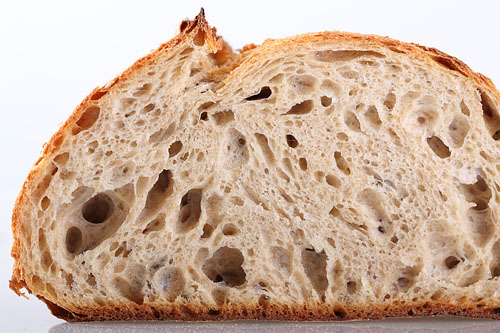
This is what the crumb looks like, up close…




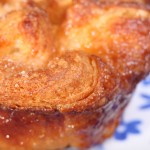
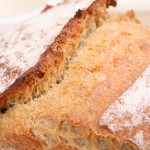
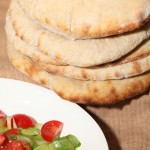
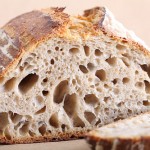

Samira says
Oh my God. I loved the oven spring part! So cool.
Thank’s for all the instructions.
Weekend Bakers says
Thank you Samira, for liking it so much!
Happy baking!
Pat mccollum says
How does this tecnique work with yeast bread and do you get the holes you get in sourdough breadI need to know for a class. Thanks for your help!
Weekend Bakers says
Hi Pat,
If you want to make a yeast based bread you can get about the same results as long as you stick to making the preferment / poolish. Instead of the 10 g sourdough you add 0.5 grams / a quarter teaspoon instant yeast to the poolish and also leave that to develop for 12 hours and add it to the final dough.
Good luck with it and happy baking and teaching!
Susan says
Absolutely brilliant video.
Helen Marshall says
Waarom gebruiken jullie gist?
Is de bedoeling niet om zuurdesem brood te maken?
Helen
Weekend Bakers says
Hallo Helen,
Dit is een zogenaamd ‘hybride’ brood waarbij je gist en desem gebruikt. Dit heeft als voordeel dat je de smaakontwikkeling van een zuurdesem hebt en de snelheid en de voorspelbaarheid van een gistbrood. Een hybride brood geeft qua structuur en korst ook weer een iets ander resultaat in vergelijking met een volledig desembrood. Het is dus een keuze, afhankelijk van je eigen wensen en eisen. Als recept voor een volledig zuurdesembrood kunnen wij onze Pain Naturel aanraden: www.weekendbakery.com/posts…esembrood/
Marieke & Ed
Jacek says
I do SF style bread but mainly from wheat strong bread flour and prefer to keep the dough in the fridge for 8 – 12 hours after initial 8 hours in a room temperature. I never use a precision weighting the ingredients but my way of preparing and baking is close to yours but I keep my starter in a room temp., feed daily and bake every 2 – 3 days, sometimes daily. Nice video of rising dough, nice page, Jacek
Mike Dintelman says
WOW!! What a great video. Never saw “spring” in motion. Good video’ing.
Question: Where can I find the polypropylene white mixing bowl you are using. I can’t find them anywhere.
You guys are great….. Thanks big time .
Mike
Michele says
Thanks for sharing this video! As a novice trying to learn home bread baking, I find your website very helpful and interesting. Thanks again for sharing your tips and knowledge.
Matthias says
Hey,
nice video. I have two questions:
– You seem to use a Häussler Alpha kneeding machine (I am using the Alpha with one gear): Since I do not have the slow gear, I am sometimes not sure how long I should kneed the dough. Do you have any hints on that?
– During baking, you start releasing the steam. I am using a stone oven as well. Since the oven is hermetical closed, the steam stays in, util I open the door (which I normaly do to take the bread out). Is there a reason why you release the steam early?
Greetings and many thanks for your answer in advance
Matthias
(from Stuttgart/Germany)
Weekend Bakers says
Hello Matthias,
We actually also have a one speed Alpha. For the pain rustique we knead one minute before the autolyse stage and 3 to 4 minutes after.
There is definitely a reason to release the steam. The steam is used in the first stages of baking to keep the skin on the bread soft so it can expand. After this expanding (oven spring!) and after the bread has stabilized you want to get rid of the steam because you want the water to vaporize, the bread cooked and the crust to get and stay crusty after baking. If you are looking for a soft crust bread or bread rolls then of course you want to keep the steam in the oven as much as possible.
Happy Baking!
Ed & Marieke
Marieke says
Hello Dick Thomson,
The recipe is based on Jeffrey Hamelman’s recipe for Pain Rustique which you can find in his book ‘bread’. Ed adapted it for our oven and climate, flour from our local mill etcetera and added his own way of shaping. The best way to try and ‘make it your own’ is to start with the Hamelman recipe. You can find a lot of information on this subject at www.thefreshloaf.com a.o..
Have fun with the baking!
Marieke
Mimi says
That was the coolest video ever! Thank you Baking Man.
dick thompson says
I was looking for the recipe that was used to build your bread dough. Looks good.
Marieke says
Hi Jenny,
These are the hands of Ed, my husband, you see in the movie. Some hands are made for playing the piano, some for making bread. Ed has that special touch and also the confidence to handle the dough. But I must say our bread oven (with the chamotte stones) is also a big help in getting the bread to it’s final shape, taste and texture.
Jenny says
Marieke – what a lovely video and oh yes, the rise was fantastic. I’m totally inspired to try this out, although I do lack equipments in my kitchen. Hope I can still get the same outcome using my pair of hands!
Marieke says
Hi Marc,
Thank you very much!
I know what you mean. I use the book ‘pastry’ by Michel Roux, which has the recipes for Pâte brisée,Pâte sucrée, sablée etcetera, I like it very much. People in Holland tend to appreciate the Dutch apple pie best which is sort of understandable, it’s what we grew up with. But I made an apple pie that’s sort of Dutch with a French twist that’s also a hit with friends and family (see: www.trifles.nl/2007/…h-affaire/) maybe it’s because of the Calvados??.
Fresh yeast in a supermarket in Holland? I have never seen it. And most of the bakers over here are no real bakers any more, but stores that get their bread delivered from a bigger factory. Try asking them for fresh yeast and you can guess what happens…
But like I said, the sourdough cultures are really thriving so less need for yeast, fresh or dry.
Have fun with the baking Marc!
Marieke
Marc says
Hello Marieke, thank you for your scientific response on autolyse, luckily we do not need to be biologists to bake great bread! I understand the technique of stretch&fold, very much like “fraiser la pâte” when making a crust for a french style apple pie (you know, the very flat beautiful looking and tasting one) for instance, where you push three or four times the mixture of flour, butter and egg/milk away without kneading, which would turn the pastry too elastic and result in a totally different texture and taste (merci Bocuse!).
Ok for the dried yeast, I have never used it myself. If you say so I believe it immediately! Fresh yeast goes bad quite quickly, and you never have it when you need it (hurray for Jumbo that always has it, those 42 gram cubes like every supermarket in Switzerland or France has). Dried yeast surely solves that problem.
I appreciate very much your site and your swift responses to reactions. Keep it up!
Marc
Marieke says
Hi Marc,
Thanks for your kind remarks! In biology terms autolysis refers to the destruction of a cell through the action of its own enzymes (also known as self digestion). In bread baking terms it means a mixing of water and flour (and preferment) and letting it rest for at least twenty minutes. The flour and water are mixed enough that they are thoroughly incorporated, but not beyond. This allows the flour to hydrate and the enzymes to start working, particularly protease which works to break down the protein in the flour. The goal of autolyse is to make the dough stronger and more extensible, better able to stretch without tearing (in our movie you also see us using the ‘stretch & fold technique). The well hydrated protein forms stronger gluten chains, while the protease works to break down some of the gluten for better extensibility. All of this happens without mixing, so less oxygen is mixed into the dough, which causes the bleaching of colour and flavour.
This technique was invented by Raymond Calvel, a French baker who wrote “The Taste of Bread”, considered a ‘bread bible’ by many. Mr Calvel has been credited with creating a revival of French-style breadmaking. He also taught Julia Child.
If you are into bread baking yourself, it’s really worth considering this technique. Less kneading and better taste and texture..who wouldn’t want that! All you need is time.
Marieke
PS: the use of fresh or dry yeast is a whole other discussion. We have used both fresh and dry yeast and do not see that much difference. Advantage of these Calvel techniques is you also use way less yeast than you do with the more ‘regular’ recipes. We DO see difference in bread quality and taste, and much more so, when using different techniques, more time, different flour and also when using our own sourdough cultures, which we are using more and more.
Marieke
Marc says
Hello Marieke, great video, thanks! a few small questions though: forgive my ignorance, but what is autolyse? I know electrolyse, für Elise ;-), but… And why not use fresh yeast?. Great oven, simply great, looking at it I can smell the bread baking.
Thanks
Marieke says
Hi Doncello,
The mixer is of German making. It’s a Häussler Alpha mixer with a 6 kilo dough capacity and removable dough hook and removable bowl, which we find really practical. We have a one speed model but recently Häussler also introduced a 2 speed model. We are very content with this mixer.
(see also www.haeussler-gmbh.de/de/pr…n.php?id=3)
Regards,
Marieke
Doncello says
Wow!!! Awesome Loaf
Can you tell me anything about the mixer you use in the video? Looks pretty good mixer, isn´t it?
Thanks a lot
Marieke says
Thank you George,
What a nice analogy, also befitting the season!
We hope to do more.
Happy Holidays,
Marieke
george eckrich says
Great job! watching the oven spring was like being present at birth. Do some more posts. thanks. george
Marieke says
Thanks Magda,
Sorry our little country is so cold at the moment..and it’s only getting colder now. Stay warm with some nice hot cocoa and a lot of baking and staying close to the oven and staring through the oven window like we do! And I’m sure you are not going to regret buying that Microplane.
Marieke
my little expat kitchen says
What an interesting video. I loved it. And the shot of the bread cooking….great!
I haven’t heard that song in such a long time. Perfect choice
Magda
Marieke says
The Rofco oven has 3 floors of brick, you can bake 6 breads in one go. The oven takes about 2 hours to heat up. The first hour it heats continuous and the second hour the heat spreads evenly through the bricks and the oven only heats for a minute every 5 minutes or so. It is a Belgium handmade oven made by a small family owned company for over 20 years (www.rofco.be).
David says
I love the video! But I can’t seem to find anything on your Rofco hearth bread oven. Can you point me to more information about the oven?
Thanks!
Marieke says
It’s a song that got stuck in my head back in the 80’s. It’s from Laid Back. They are from Denmark. Better known maybe for something called ‘Sunshine Reggae’. Funny detail: A remix of ‘Bakerman’ by British DJ Shaun Baker reached number one in Greenland in 2006.
dewey says
Great video and even great loaf of bread. And by the way, who’s music are you using?
Adam Weber says
Absolutely beautiful in every way!
Great equipment, excellent (baking) technique and very good cinematic skill. Even the sound-track was cool.
Thank you very much.
Rene says
Nicely done Thanks
Postal Grunt says
Way cool!
Nico says
Ik ga me pas zorgen maken als jullie twee uur door het ruitje van de wasmachine gaan kijken 😉 Verder: een schitterend filmpje!
Nico
Marieke says
Dank je Soepkipje! Die ovenrijs is ook ons favoriete stukje film. Het heeft iets rustgevend om ernaar te staren. Normaal zitten we samen voor het ovenruitje te kijken als het brood rijst. Het filmpje van de rijs is versneld, in werkelijkheid duurt dit groeiproces ongeveer 15 minuten.
Marieke
Soepkipje says
Mooi filmpje en prachtig die ovenrijs!! :-))